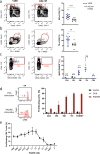Glycosylated nanoparticle-based PfCSP vaccine confers long-lasting antibody responses and sterile protection in mouse malaria model
- PMID: 37029167
- PMCID: PMC10080175
- DOI: 10.1038/s41541-023-00653-7
Glycosylated nanoparticle-based PfCSP vaccine confers long-lasting antibody responses and sterile protection in mouse malaria model
Erratum in
-
Author Correction: Glycosylated nanoparticle-based PfCSP vaccine confers long-lasting antibody responses and sterile protection in mouse malaria model.NPJ Vaccines. 2023 Jun 5;8(1):86. doi: 10.1038/s41541-023-00687-x. NPJ Vaccines. 2023. PMID: 37277334 Free PMC article. No abstract available.
Abstract
The development of an effective and durable vaccine remains a central goal in the fight against malaria. Circumsporozoite protein (CSP) is the major surface protein of sporozoites and the target of the only licensed Plasmodium falciparum (Pf) malaria vaccine, RTS,S/AS01. However, vaccine efficacy is low and short-lived, highlighting the need for a second-generation vaccine with superior efficacy and durability. Here, we report a Helicobacter pylori apoferritin-based nanoparticle immunogen that elicits strong B cell responses against PfCSP epitopes that are targeted by the most potent human monoclonal antibodies. Glycan engineering of the scaffold and fusion of an exogenous T cell epitope enhanced the anti-PfCSP B cell response eliciting strong, long-lived and protective humoral immunity in mice. Our study highlights the power of rational vaccine design to generate a highly efficacious second-generation anti-infective malaria vaccine candidate and provides the basis for its further development.
© 2023. The Author(s).
Conflict of interest statement
S.H., J. Lossin, A.O., N.L., B.F., C.J.J., S. B., P.K. declare no conflicts of interest. J. Ludwig, S.W.S., G.C., R.M., K.P., H.W., E.A.L. and J.-P.J. have filed a patent application related to the immunogens described in this work.
Figures





References
-
- WHO. World Malaria Report 2021 (WHO Press, 2021).
Grants and funding
- OPP1179906/Bill and Melinda Gates Foundation (Bill & Melinda Gates Foundation)
- OPP1159947/Bill and Melinda Gates Foundation (Bill & Melinda Gates Foundation)
- INV001759/Bill and Melinda Gates Foundation (Bill & Melinda Gates Foundation)
- INV010271/Bill and Melinda Gates Foundation (Bill & Melinda Gates Foundation)
- OPP1159947/Bill and Melinda Gates Foundation (Bill & Melinda Gates Foundation)
LinkOut - more resources
Full Text Sources

